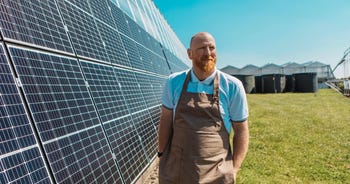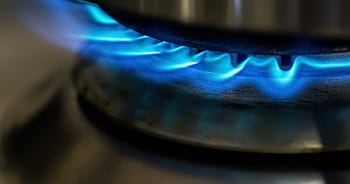What is nuclear energy? Is it a viable option for UK SMEs?
Did you know that in 2022, 15% of the UK's electricity generation was nuclear power? Your cafe, restaurant, barber, or whatever your business - may have already been powered up by this controversial energy source.
The amount of nuclear power we produce in the UK has been declining since the 1990s, and many nuclear power plants are closed or set to close down by 2030. In most cases, this is because they're coming to the end of their lifecycle or need serious repairs. But, in the UK we've got a tough net zero target to hit and because nuclear doesn't produce harmful emissions, the UK government is rethinking its use with new energy innovation projects.
However, increasing nuclear power doesn't come without risks...
But before we get into that, we’ll walk you through everything you need to know about nuclear energy, its viability as an energy solution and what this means for businesses across the country.

30-second Summary:
- Nuclear energy is generated through nuclear fusion, producing electricity with minimal greenhouse gas emissions, although it's not a renewable source of energy.
- It provides a stable and reliable source of power, especially in contrast to weather-dependent renewables.
- Nuclear energy is used in the medical field, industries for non-destructive testing, and agriculture for food safety and soil analysis.
- The benefits of using nuclear power include lower emissions, high energy density, and continuous power generation.
- The disadvantages involve radioactive waste disposal, potential accidents, and high initial construction costs. Because of the risks, the industry is heavily regulated to ensure safety and environmental protection.
- Environmental impacts include habitat destruction, water usage, land use, and vulnerability to natural disasters.
- Overall, nuclear energy can be a viable option for businesses, offering a low-emission, stable energy source as it makes up some of the nation's existing energy mix.
What is nuclear energy?
At its core, nuclear energy is a form of power produced from an atom’s nucleus. Atoms are tiny particles that make up every object in the universe, and the nucleus is the central part of an atom.
There are two main processes through which we can harness nuclear energy. But, only one is relevant when it comes to producing energy for business - nuclear fission. This is where the nucleus of the atom is split into two or more smaller parts, releasing a lot of energy. This is the process used in nuclear power plants to generate electricity.
One of the greatest perks of harnessing nuclear energy is its ability to produce a large amount of power with a relatively small amount of fuel — and without emitting greenhouse gases during the process.
Find out more about the different energy types that keep your business running with our guide to decoding the UK energy mix.
How does nuclear energy work?
Nuclear fission is the process of generating nuclear power, and it works like this:
- Fuel — The process begins with a special kind of fuel, usually pellets of uranium-235 or plutonium-239. These materials are chosen because their atoms have large, unstable nuclei on the brink of splitting apart.
- Chain reaction — When a neutron (a subatomic particle) collides with the nucleus of one of these fuel atoms, it triggers the nucleus to split into two smaller nuclei, along with a few neutrons and a high amount of energy. The neutrons that are released can then go on to collide with other fuel atoms, causing them to split and release more neutrons and energy. This creates a self-sustaining chain reaction.
- Heat production — The energy released during the fission process primarily comes out as heat. This heat is used to produce steam from water.
- Electricity generation — The steam produced then drives turbines connected to generators. As the turbines spin, they generate electricity.
What is nuclear energy used for?
You’d be surprised to know that nuclear energy isn’t just used in power plants but can be used across various industries, making it a versatile and robust power source.
Electricity generation
Nuclear power plants are at the heart of electricity generation using nuclear energy. They provide a stable and reliable source of power, capable of producing electricity on a large scale.
Unlike renewable sources like solar and wind, nuclear power plants can produce electricity continuously, regardless of weather conditions. They play a vital role in ensuring a constant supply of electricity to the grid, contributing significantly to the energy mix in many countries.
The medical field
Nuclear energy is a game changer in the medical field, especially in oncology. Radiation therapy uses high-energy radiation to shrink tumours and kill cancer cells. Delivering precise doses of radiation targets the affected area, minimising damage to surrounding healthy tissues.
Nuclear energy is also used in techniques like X-rays, CT scans, and PET scans, which rely on radiation to create detailed images of the inside of the body. These images are invaluable for diagnosis, helping doctors see what’s happening inside a patient’s body and plan treatments accordingly.
Industrial applications
Industries use nuclear techniques to test materials for flaws and defects. This non-destructive testing ensures the integrity and safety of structures and components, especially in areas like aerospace, where material failure can have really bad consequences.
Just like in medical imaging, nuclear energy also plays a key role in radiography in industries that use radiation to see inside objects. This is key for inspecting welds, castings, and other parts to ensure they meet safety and quality standards.
Agriculture
To ensure food safety and extend shelf life, some foods are irradiated — exposed to lower levels of radiation. This process kills bacteria and parasites that can cause foodborne diseases, such as in milk or canned fruit and vegetables.
According to the Food Standards Agency, in the UK, irradiation can only be used where it's of benefit to the consumer, so a company must show that the benefits of irradiation outweigh any negatives.
Agriculture also benefits from nuclear techniques in soil analysis and water management. Understanding soil composition and water movement helps optimise crop yields and manage resources efficiently, which is increasingly important in a world facing water scarcity and climate change.
What are the advantages of nuclear energy?
Using nuclear energy can have a wide range of advantages:
Lower greenhouse gas emissions
One of the most significant advantages of nuclear energy is its minimal greenhouse gas emissions during operation. Unlike fossil fuel-based power plants, nuclear reactors do not burn fuel and, therefore, do not emit carbon dioxide (CO2) during electricity generation. This makes nuclear a strong option for reducing overall greenhouse gas emissions and combating climate change.
High energy density
Nuclear energy has an incredibly high energy density compared to fossil fuels. A small amount of nuclear fuel can produce a massive amount of energy. This means that nuclear power plants require less fuel and have a smaller physical footprint to produce the same amount of electricity as fossil fuel plants.
The high energy density also contributes to the cost-efficiency of nuclear energy. Though the upfront costs of building a nuclear power plant are high, the long-term operational costs can be lower due to the efficiency of nuclear fuel.
Continuous power generation
Nuclear power plants can continuously generate electricity for 18-24 months before shutting down for refuelling which can take about 10 days. They provide a stable and reliable source of energy, ensuring a consistent electricity supply.
Reduced air pollution
Unlike coal or gas plants, nuclear reactors do not emit air pollutants like sulfur dioxide, nitrogen oxides, or particulate matter during operation. This contributes to cleaner air and better overall air quality, which is crucial for public health.
And this cleaner air can lead to fewer respiratory issues, heart conditions and other health problems associated with air pollution.
What are the disadvantages of nuclear energy?
While having a range of advantages, like most things, nuclear energy also comes with its disadvantages.
Radioactive waste disposal
One of the biggest challenges of nuclear energy is dealing with the radioactive waste it produces. This waste remains hazardous for thousands of years and requires secure, long-term storage solutions.
Unfortunately, limited facilities are available worldwide to safely dispose of nuclear waste. Finding suitable locations for waste storage that are geologically stable and away from populated areas is a complex process and one that still needs to be fully ironed out.
Risk of accidents
While nuclear accidents are rare, their potential impact can be severe, as seen in incidents like Chornobyl and Fukushima. Accidents can lead to the release of radioactive materials, causing long-lasting environmental damage and health issues to those in the affected area.
In the event of a nuclear accident, large areas may need to be evacuated, and the land around the nuclear plant could be contaminated for an extended period, displacing communities and affecting local economies.
High initial construction costs
Nuclear power plants are incredibly complex and require a significant investment to build. The high upfront costs and lengthy construction times can make nuclear projects less attractive compared to other energy sources that can be constructed at half the cost.
The return on investment for a nuclear power plant takes several years, which can be unattractive for investors looking for quicker returns.
What is the cost of disposing of nuclear energy?
The cost of disposing of nuclear waste in the UK is large and depends on various factors, including the type of waste, the disposal method, and the long-term management of disposal sites.
However, according to a report from the National Audit Office (NAO), the cost of decommissioning the UK’s nuclear sites could be up to £260 billion — which is double the current estimate of £56 billion.
How safe is nuclear energy?
When we think about nuclear energy, safety can often be a touchy subject - but there isn't a need to worry. Due to the nature of how nuclear energy is handled and how well the industry is regulated, the plants are designed with a plethora of safety features, ensuring that everything runs smoothly and securely.
Regular check-ups and maintenance, like routine plant health checks, ensure they are in top-notch condition. While there have been a few incidents in the past, they have paved the way for learning and improvement, leading to even safer nuclear technology today.
What are the environmental impacts of nuclear energy?
Nuclear energy is known for its low greenhouse gas emissions during electricity production but has various environmental impacts throughout its lifecycle.
- Mining and fueling processing — The mining of uranium — the primary fuel for nuclear reactors — can lead to habitat destruction and soil erosion. It can also contaminate local water sources with radioactive and toxic substances. Turning the mined uranium into usable fuel involves chemical processes that can produce hazardous waste, so careful management is needed to prevent environmental harm.
- Water usage — Nuclear power plants use large quantities of water for cooling. This can impact local rivers, lakes and ecosystems, especially if the water is discharged at elevated temperatures. Another issue is that some of the water used for cooling is lost to evaporation. This can be a particular concern in regions where water is scarce.
- Land use — While nuclear plants have a relatively small physical footprint compared to some renewable energy sources, the need for safety buffer zones means they still require significant land use. The need for such land — especially for long-term storage and waste solutions — can have potential impacts on local ecosystems and communities.
- Vulnerability to natural disasters — Rising sea levels and extreme weather events pose risks to coastal and riverside nuclear plants, potentially leading to environmental contamination if a power plant is damaged. In earthquake-prone countries, the potential for natural disasters must be carefully considered in the design of nuclear facilities to prevent accidents and environmental harm.
Get your business set with Bionic
Now that you know all about nuclear power, why not brush up on your knowledge of other energy sources with our energy guides?
And if you need more help understanding how business energy, get in touch today with the Bionic team. We’re on hand to help with contracts for business electricity, business gas and more.








